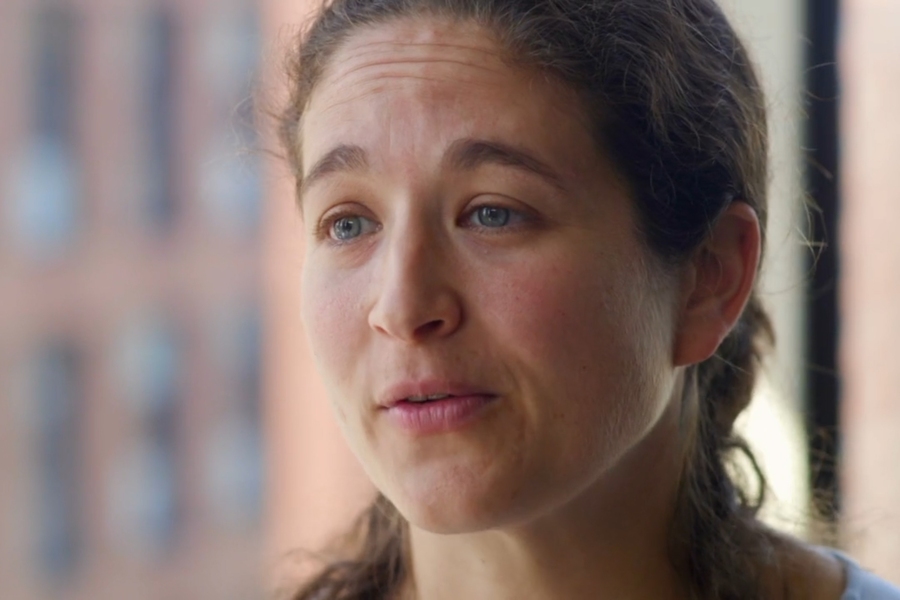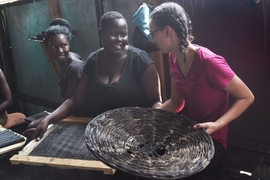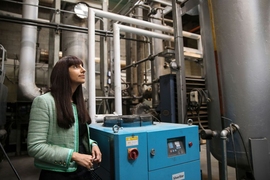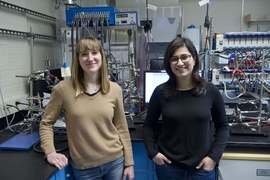Elsa Olivetti’s interest in materials science began when she was an engineering science major at the University of Virginia. Initially unable to settle on any one form of engineering, she took an introduction to materials science class on a whim. She loved the way materials science let her examine everyday material, like a block of wood or piece of cloth, on a molecular level. “Being able to think across those scales is something that I found really cool,” Olivetti says.
Now, Olivetti is an associate professor in the MIT Department of Materials Science and Engineering and the principal investigator of her own lab. Her interest has turned to the social and environmental impacts of the materials we use in our daily lives. Specifically, the Olivetti lab looks at the huge quantities of industrial waste materials generated in the manufacturing industry, in the hopes of finding useful ways to reconstitute and reuse this waste for building.
Some types of waste have already become standard tools in the building industry: fly ash from burning coal, for instance, is increasingly used in concrete as a substitute for freshly produced cement. Most types of industrial waste, however, are simply discarded as useless byproducts. Olivetti hopes to change that. By applying her understanding of materials on a molecular level, she can propose new ways these byproducts might be integrated into usable building materials to make the industry more efficient.
Several years ago, Olivetti was able to put that idea to the test by participating in a Tata Center project launched in a city called Muzaffarnagar in northern India. The area is highly industrial, containing pulp and paper mills and steel and brick manufacturers. “But the challenge there is they don’t have a lot of resources to put into environmental abatement,” Olivetti says. “They’re just dumping.”
So, the Tata Center team went looking for byproducts that could potentially be put to another use. They noticed that the pulp plants were powered by sugar cane and rice husks, which were burned to generate energy. The byproduct of these burnt plant materials was something called “biomass ash,” which has “pretty high, fairly reactive silica content.” This means that it can bind with other materials to produce a strong, cement-like structure.
They were able to demonstrate that this ash, which had previously been dumped as waste, could actually be turned into cheap building material, providing an economic and environmental benefit to the local community. The end result, produced in 2015, was dubbed the Eco-BLAC brick. In 2017, Olivetti received an Environmental Solutions Initiative (ESI) seed grant to continue this work back at MIT.
“What we used the ESI money for is to move outside of biomass ash and into other materials,” Olivetti says. She summarizes the work as “beyond India, beyond ash.” She’s most interested in the kinds of materials where “there’s still enough quantity to make it useful, but they aren’t already well-utilized,” a rubric that has brought her focus to metal waste products, especially the “slag” left over during copper production.
Olivetti is particularly fond of the ESI project because “it pulls together a bunch of different dimensions of what I like to think about.” When trying to understand which metal waste materials might be put to the best use, she has to ask a few key questions. First, is the waste material reactive, like the biomass ash material was? Can it bind with other materials to add strength and integrity? How reactive is it? What will it react with, and under what conditions? Or, is the material non-reactive? Non-reactive materials don’t necessarily add value, but can be used to add volume, just as sand is mixed with cement to produce concrete.
Once she figures out what role the material might play, she has to understand its durability in the environment where it will be used. Biomass ash, for instance, has a lot of carbon, and one implication of this is that it takes in water. This might not be a problem in India, where it is warm year-round, but it can harm the structural integrity of a material that will be used somewhere like Boston, Massachusetts, where winter temperatures drop below freezing.
To test all these things, she needs to do something a little bit counterintuitive. “One of the things we’ve started to do, which has been kind of fun, is synthesize waste,” she says. “Which feels silly when I say it like that.”
A recurring problem with researching waste is that it involves substances people have typically ignored. It’s rare for any industry to keep careful track of what its waste is made up of, or how much of it is produced. When making copper, for instance, the end product is always copper. But there might be several different kinds of unintended waste products that are produced along the way, which all get mixed together. Olivetti describes the end result as “Jell-O with a bunch of fruit in it.”
By artificially manufacturing the waste, Olivetti can better understand how much of each waste product is produced, and how to best separate it into usable materials. The question of quantity is another one that becomes trickier to answer when dealing with waste material. While a steel factory, for example, has an incentive to measure its steel production, it has little incentive to keep detailed records of how much material it’s wasting.
“I think overall what this field needs is better cataloging of what wastes are going to be where, and trying to project that a little bit,” Olivetti says. “If it’s a raw material for making something, you need to know that supply’s going to be steady.” A key component of any business is having a stable supply, so in order for all this waste material to be used more widely, there need to be better records of what kinds of waste are being produced where, and in what quantity. Now, Olivetti is working on a project using AI to automatically extract information about how various materials are made, to try to better understand the supply chain and where the most promising byproducts are being created.
She’s also hoping to better understand the environmental impact of using waste materials, to ensure that there will be no harmful effects of repurposing these substances. If even one of the Olivetti lab’s discoveries is widely adopted, her research will have contributed to a materials supply chain that is much more efficient, cost-effective, and environmentally sustainable than ever before.









